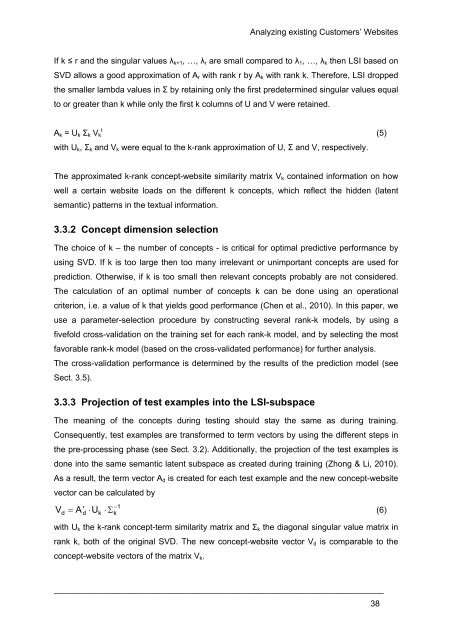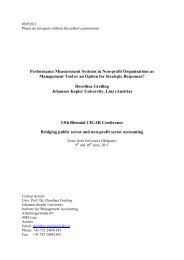ESSAYS ON TEXT MINING FOR IMPROVED DECISION MAKING ...
ESSAYS ON TEXT MINING FOR IMPROVED DECISION MAKING ...
ESSAYS ON TEXT MINING FOR IMPROVED DECISION MAKING ...
You also want an ePaper? Increase the reach of your titles
YUMPU automatically turns print PDFs into web optimized ePapers that Google loves.
Analyzing existing Customers’ Websites<br />
If k ≤ r and the singular values λk+1, …, λr are small compared to λ1, …, λk then LSI based on<br />
SVD allows a good approximation of Ar with rank r by Ak with rank k. Therefore, LSI dropped<br />
the smaller lambda values in Σ by retaining only the first predetermined singular values equal<br />
to or greater than k while only the first k columns of U and V were retained.<br />
Ak = Uk Σk Vk t (5)<br />
with Uk, Σk and Vk were equal to the k-rank approximation of U, Σ and V, respectively.<br />
The approximated k-rank concept-website similarity matrix Vk contained information on how<br />
well a certain website loads on the different k concepts, which reflect the hidden (latent<br />
semantic) patterns in the textual information.<br />
3.3.2 Concept dimension selection<br />
The choice of k – the number of concepts - is critical for optimal predictive performance by<br />
using SVD. If k is too large then too many irrelevant or unimportant concepts are used for<br />
prediction. Otherwise, if k is too small then relevant concepts probably are not considered.<br />
The calculation of an optimal number of concepts k can be done using an operational<br />
criterion, i.e. a value of k that yields good performance (Chen et al., 2010). In this paper, we<br />
use a parameter-selection procedure by constructing several rank-k models, by using a<br />
fivefold cross-validation on the training set for each rank-k model, and by selecting the most<br />
favorable rank-k model (based on the cross-validated performance) for further analysis.<br />
The cross-validation performance is determined by the results of the prediction model (see<br />
Sect. 3.5).<br />
3.3.3 Projection of test examples into the LSI-subspace<br />
The meaning of the concepts during testing should stay the same as during training.<br />
Consequently, test examples are transformed to term vectors by using the different steps in<br />
the pre-processing phase (see Sect. 3.2). Additionally, the projection of the test examples is<br />
done into the same semantic latent subspace as created during training (Zhong & Li, 2010).<br />
As a result, the term vector Ad is created for each test example and the new concept-website<br />
vector can be calculated by<br />
V<br />
d<br />
= A′<br />
⋅U<br />
⋅ Σ<br />
(6)<br />
d<br />
k<br />
−1<br />
k<br />
with Uk the k-rank concept-term similarity matrix and Σk the diagonal singular value matrix in<br />
rank k, both of the original SVD. The new concept-website vector Vd is comparable to the<br />
concept-website vectors of the matrix Vk.<br />
_______________________________________________________________________<br />
38

















